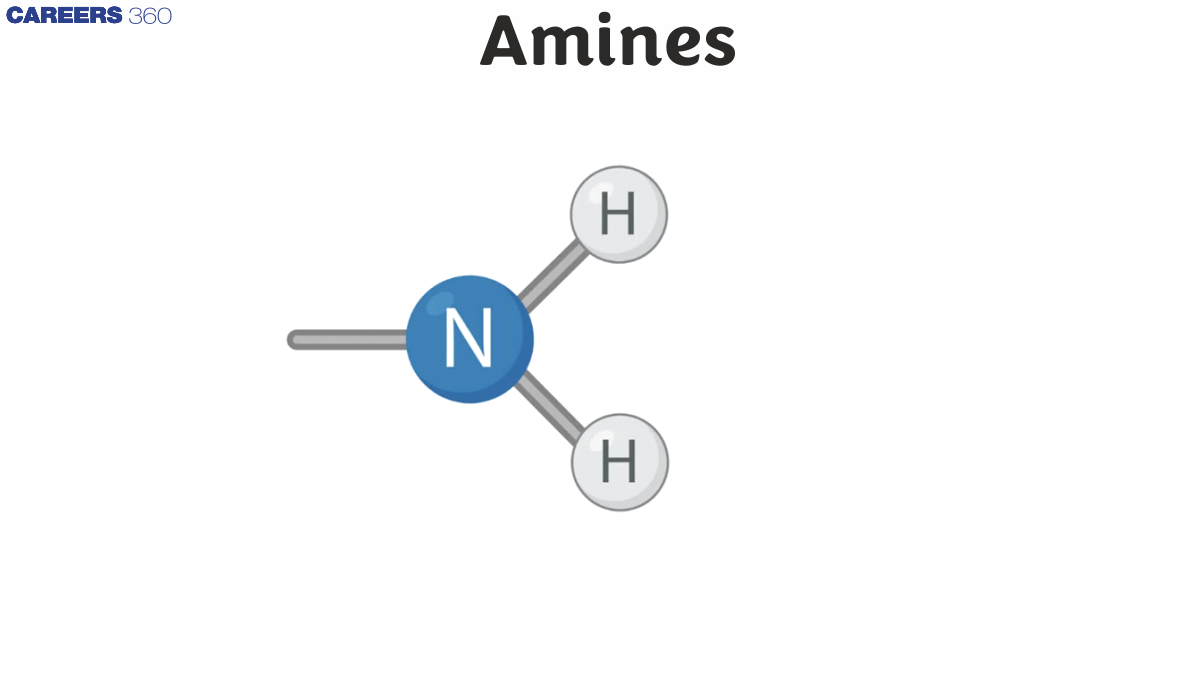Amines - Overview, Examples, Types, Properties, FAQs
Under living chemicals, the definition of Amines is accepted as a component of ammonia. It is a composite chemical compound divided into organic nitrogen compounds consisting of two electrons with nitrogen atoms having forumla R-NH2. Also, aromatic primary amines cannot be prepared by gabriel phthalimde synthesis. Basically, in Amines hydrogen atoms are replaced by an alkyl or aryl group. With this basic definition of amines, let's learn about the different types of Amines, amine structures and naming systems. Amine is a functional group in which a nitrogen atom with lone pair of electron is attached to one or more alkyl/aryl groups.
NEET 2025: Mock Test Series | Syllabus | High Scoring Topics | PYQs
JEE Main: Study Materials | High Scoring Topics | Preparation Guide
JEE Main: Syllabus | Sample Papers | Mock Tests | PYQs
- Types of Amines
- 1) Primary Amines and their examples
- 2) Secondary Amines (2° Amines)
- 3) Tertiary Amines (3° Amines)
- 4) Quaternary Amines (4°Amines)
- Nomenclature of Amines
- Properties of Amines

Types of Amines
Amines are divided from natural to aliphatic Amines and sweet Amines. In addition to Amines, aryl and alkyl are also divided into three categories based on the calculation of nitrogen atoms associated with nitrogen and the number of hydrogen atoms replaced. They are next -
1) Primary Amines and their examples
Primary Amines or 1 degree amines are formed when one of three hydrogen atom in ammonia compound is replaced by an aromatic or an alkyl group. Some of the examples of Amines are methylamines and tris-buffering agent.
2) Secondary Amines (2° Amines)
Similarly, Secondary Amines are formed when two carbon atoms are bonded to the nitrogen and the tert Amines have three following carbons bonded to nitrogen.
3) Tertiary Amines (3° Amines)
High Amines are known when nitrogen has three elements. Examples of high Amines are trimethylamines and EDTA.
4) Quaternary Amines (4°Amines)
The quaternary Amines is well-drained and is where nitrogen contains four living things as well
Interestingly, the fourth phase of Amines known as cyclic Amines exists and cyclic Amines are derived from the interactions of nitrogen-connected materials. However, circulating Amines are second or higher Amines. Examples are a six-part ring piperidine or aziridine ring with 3 members.
Nomenclature of Amines
Nomenclature of Amines: The “e” in ending of name of alkane shows longest chain is which is replaced with Amines. The Amine group is located by position number.
Related Topics |
Properties of Amines
Low amphibious Amines have a fishy-like odor.
Basic Amines are a liquid at room temperature that contains three to four atoms in carbon, while the higher Amines are solid.
Aniline and other aryl Amines are usually colorless. However, when stored in an open area, they are painted due to atmospheric oxidation.
Low-density Amines aphids dissolve in water as they form bonding with the hydrogen atom of water. However, as the fraction of the hydrophobic alkyl component increases, the weight of the Amines molar decreases and the solubility also decreases.
Ground Amines do not melt. Organic solvents such as ethanol, benzene, and ether are used to dissolve Amines easily.
Primary and secondary Amines are often involved in the interaction of anime molecules because of the interaction of hydrogen with nitrogen that interacts with the hydrogen of other atoms.
Intermolecular strength is seen more in the
basic Amines compared to the secondary due to the presence of two hydrogen atoms. In contrast, high Amines have no intermolecular potential due to the lack of free hydrogen atoms.
Aromatic Amines are relatively reduced than aliphatic Amines because two pairs of nitrogen atoms are formed and are less available with acid.
NCERT Chemistry Notes :
Frequently Asked Questions (FAQs)
The NH₂ group is called an amine group when it is part of an organic compound. It is referred to as an amino group in molecules, but amines are compounds that contain one or more NH₂ groups attached to carbon atoms.
The general formula of amine is R-NH₂, where "R" represents an alkyl or aryl group attached to the amine group (NH₂). Amines can further be classified as primary ( R-NH₂), secondary (R₂NH) or tertiary (R₃N) amines, depending on how many alkyl or aryl groups are attached to the nitrogen atom.
In tertiary amine (3°), the nitrogen atom is bonded to three alkyl or aryl groups and has no hydrogen atoms attached to it. Example of a tertiary amine is trimethylamine (N(CH₃)₃), where the nitrogen is attached to three methyl (CH₃) groups.
Amines are generally weak bases, and their pH in aqueous solution is generally above 7, ranging from 8 and 11. The exact pH depends on the type of amine and its concentration.
Amines are generally considered an easier chapter in chemistry due to their straightforward definitions and reactions, especially for those with a basic understanding of the subject.
Also Read
09 Dec'24 10:55 AM
19 Oct'24 10:31 AM
18 Oct'24 01:11 PM